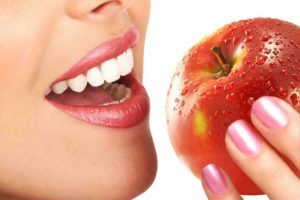 Gingivitis is an extremely unpleasant gum disease associated with an inflammatory process in their mucous membrane.
Gingivitis is an extremely unpleasant gum disease associated with an inflammatory process in their mucous membrane.
Despite the complexity of this disease, it is possible to alleviate the condition at home.
Contents
- Symptoms and diseases - provocateurs
- Symptoms of the disease at different stages
- Complex treatment - the pledge of a speedy recovery
- Vitaminotherapy
- Application of medical treatment
- Ointments and gels
- Antiseptics
- Selection of toothpaste is important
- How to remove gum disease with folk remedies
- Preventive measures
Factors and diseases - provokers
The causes of gingivitis can serve as:
- trauma , associated with the formation of calculus, mDamage to the gums or prostheses.
- disrupts the hormonal background of , which is why diseases are often susceptible to pregnant women and adolescents during puberty;
- lack of vitamins and, as a consequence, decreased immunity, gastrointestinal diseases, poor oral hygiene can also contribute to the development of gum disease;
- AIDS, tuberculosis, diabetes mellitus and other chronic diseases , contribute to the emergence and development of gum disease.
The disease affects only the mucous membrane, without violating the integrity of the teeth, so it is considered a fairly easy gum disease, provided the treatment is started in time.
If acute gingivitis is not treated early, then its course can develop into a chronic one. In this case, getting rid of it will be much more difficult.
The main reason is insufficient hygiene of the oral cavity, when the soft coating remaining on the border of the tooth with the gum gradually turns into tartar. In this place, bacteria that cause inflammation and swelling of the gums begin to multiply actively. This process causes the disease "gingivitis".
Symptoms of the disease at different stages of
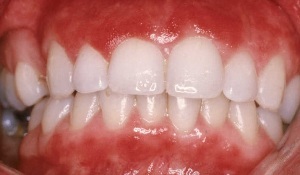 The signs of gingivitis vary depending on the form of the disease. The more severe and neglected the disease, the more pronounced the puffiness and hyperemia of the gums.
The signs of gingivitis vary depending on the form of the disease. The more severe and neglected the disease, the more pronounced the puffiness and hyperemia of the gums.
Symptoms of acute disease are:
- difficulty in chewing food;
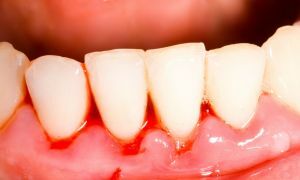
- bad breath;
- gum bleeding.
With chronic, they are not so pronounced. There is a tolerable discomfort, bleeding gums can increase.
Gingivitis is often confused with stomatitis, paradontosis and periodontitis, since they have similar symptoms, the diagnosis can only be diagnosed by a doctor-paradontologist.
Complex treatment is the keystone of the soonest recovery
Since gingivitis is an inflammation, the treatment is aimed at its elimination. Dentists, along with medications advise the use of traditional medicine.
First you need to establish the root cause of inflammation, if the gum is injured by a seal, the doctor will correct it or replace it with a new one.
Vitaminotherapy
The doctor prescribes vitamins, as gingivitis often occurs due to reduced immunity. Especially relevant in this case is vitamin C, which strengthens the walls of blood vessels, increases the body's resistance to diseases and reduces bleeding gums.
Medications for medical use
Antibiotics are used in severe forms of gingivitis, when local therapy does not allow to cope with the pathological process. Since inflammation of the gums causes gram-negative microorganisms and protozoa, the following drugs are used to control them: 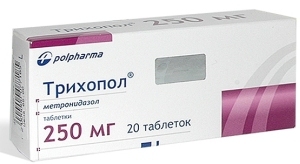
- Trichopol( metronidazole) - is active against protozoa. Assign 2t.( 0.5g) twice a day for 10 days. Do not appoint children under 6 years and pregnant.
- Ciprofloxacin( Cyprolet, Cyphran) - A group of fluoroquinolones adversely affects gram-negative microbes. They use 1 t.(0.5g) in the morning and in the evening. Contraindicated in children under 14 years of age and pregnant;affects the growth and formation of bones.
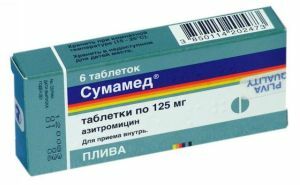
- Azithromycin( Azitrox, Sumamed, Hemomycin) - Refers to a group of macrolides active against gram-negative and anaerobic infections. Treatment schedule: 500 mg - once a day for 5 days. It is allowed to children( the dosage is calculated by the doctor according to body weight) and pregnant.
Ointments and Gels
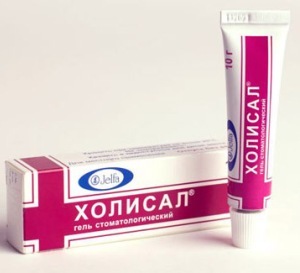 Ointments and gels are used to eliminate the focus of inflammation. Gels in this case are preferable, becausetheir base contributes to a better absorption of the active substance in the gum tissue.
Ointments and gels are used to eliminate the focus of inflammation. Gels in this case are preferable, becausetheir base contributes to a better absorption of the active substance in the gum tissue.
The most commonly used are "Kholisal", "Asepta", "Apident-asset".These drugs effectively fight with inflammation, relieve uncomfortable sensations, reduce bleeding. Apply them several times a day to the focus of inflammation, the application gives good results.
"Solcoseryl"( strengthens the walls of blood vessels) and "Metrogyl denta"( has an antimicrobial effect), which permanently eliminate painful sensations, covering the painful gum with a kind of film, are also well recommended, thus protecting it from external influences.
Antiseptics
Among others, the following are popular:
- Chlorhexidine. A 0.05% aqueous solution is used to rinse the mouth. In addition, water is not diluted with
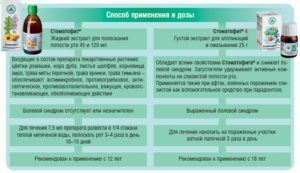 .Has a powerful antiseptic effect.
.Has a powerful antiseptic effect. - Stomatophyte is a herbal solution. It is used for various forms of gingivitis to relieve inflammation. Recommendations for use are shown in the photo.
- solution of furacilin is no less effective. It has a harmful effect on harmful microorganisms, reduces bleeding, reduces pain. Two tablets are dissolved in half a glass of warm water, beforehand it is desirable to crush them. To rinse it is necessary two times a day - in the morning and before a dream.
The choice of toothpaste is important
It is very important to observe the rules of personal hygiene during the treatment period. Toothpaste should be enriched with herbal ingredients such as sage, St. John's wort, chamomile, calendula. It is necessary to clean the tooth enamel and mucous, no matter how painful it is to feel when the brush touches the sore spot.
Brush for the period of treatment should be chosen soft, which does not injure inflamed gums.
How to remove gingival inflammation folk remedies
Conventional baking soda perfectly removes inflammation and kills bacteria. Rinse preferably at least 4 times a day. The solution is prepared as follows: 1 teaspoon of soda for a glass of water.
Traditional medicine recipes for the treatment and prevention of gingivitis:
Many herbal components are natural antiseptics and are able to effectively remove inflammation.
The most effective of them:
- herbs such as chamomile, sage, celandine and oak bark are excellent in the inflammation of the gums. Make the broth very simple, you need to take 100 grams of dried plants, pour a glass of boiling water and let it brew for 4 hours. After each meal, rinse your mouth with a herbal decoction.
- Aloe perfectly helps with inflammation and relieves pain. Cut the aloe leaf along the fibers, apply to the sore spot for the night. Or you can use another method: squeeze out the juice from the aloe, moisten the sterile bandage and also apply to the site of inflammation.
-
 Not only herbs help with gingivitis, but also some berries. For example, blueberry is an excellent remedy for inflammation. You can use fresh berries and rinse your mouth with juice from them. You can also use dried crushed berries, which are steamed hot water to prepare a decoction. Bilberry is a powerful remedy when fighting bacteria and microorganisms.
Not only herbs help with gingivitis, but also some berries. For example, blueberry is an excellent remedy for inflammation. You can use fresh berries and rinse your mouth with juice from them. You can also use dried crushed berries, which are steamed hot water to prepare a decoction. Bilberry is a powerful remedy when fighting bacteria and microorganisms. - Pomegranate is no less effective than blueberries, as it promotes healing of gums. In this case, the skin is used, not the grain. It must be thinned, poured cold water( 500 ml) and boil in half. Gargle with gum to rinse.
Preventive measures
During the period of illness, you need to consume as much freshly squeezed juices as possible to replenish the body's lack of vitamins. Solid fruits and vegetables can injure inflamed gums, so it is better to exclude them from food for the period of the disease. Also, it is necessary to abstain for a time from flour and sweet, as these products contribute to the occurrence of plaque.
Recommendations for oral care to prevent inflammation of the gums from the dentist - hygienist:
Gingivitis is a very unpleasant disease, but to protect yourself from its appearance is available to everyone. You just need to follow simple rules and do not be lazy to observe personal hygiene:
- brushing your teeth after breakfast and before bedtime;
- cleaning of the tongue( special scraper);
- a timely visit to the dentist( twice a year);
- use of dental floss and rinse aid after eating;
- rejection of bad habits - smoking, abuse of coffee, tea, alcohol;
- the use of food rich in calcium( dairy and sour-milk products);
- fresh fruits and vegetables in this case will be very handy, becausetheir solid varieties contribute to the removal of plaque and natural gum massage.
